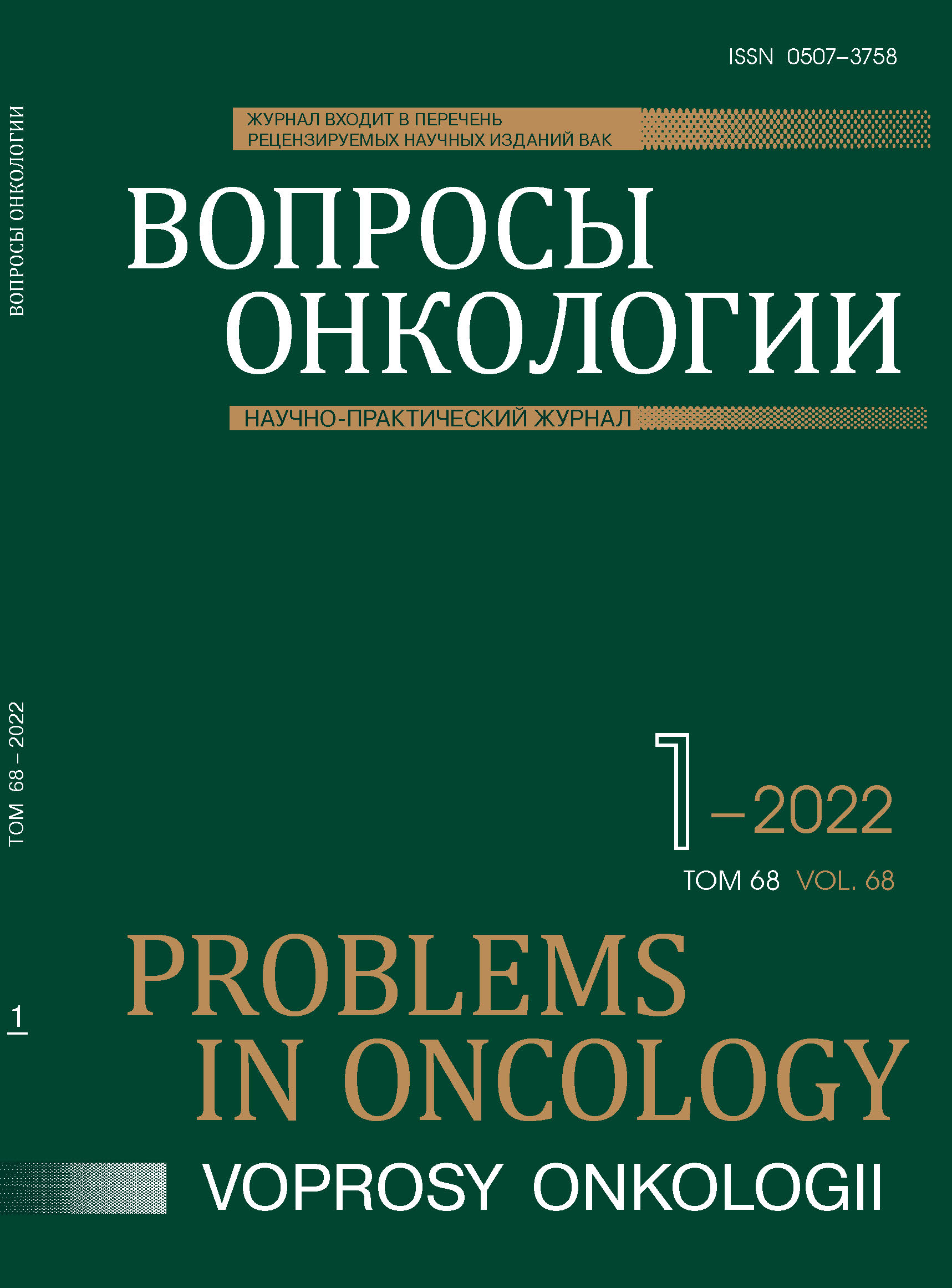Abstract
Background. Hormones and their receptors are important effectors providing interconnection between the primary tumor and metastatic niches.
The aim of the study was to determine levels of prolactin (PRL), sex steroid binding globulin (SSBG), steroid hormones and their receptors in tissues of gastric cancer (GC), omentum and peritoneum.
Materials and methods. Levels of PRL, SSBG, steroid hormones and their receptors were determined by ELISA in tissues of primary tumors, omentum and peritoneum in main groups: 1 (M0) — GC T3–4аN0–3M0 (n=24) and 2 (M1) — GC T3–4аN0–3M1 (n=21); in tissues of the stomach, omentum and peritoneum — in the comparison group — non-cancer patients (n=17).
Results. GC (М0) was characterized by high levels of estrogen receptors (ER) α — by 1.2 times (p<0.05), progesterone (PR) — by 3.5 times and SSBG — by 1.4 times (p<0.05); tissues of the omentum and peritoneum showed increased levels of ERα — by 2.4 and 3.9 times, ERβ — by 1.5 (p<0.05) and 2.5 times, РR — by 2.2 and 1.5 times (p<0.05). GC (М1) had low ERα levels; in tissues of GC, omentum and peritoneum, estradiol was reduced — by 4.2, 4.0 and 8.6 times, respectively, free testosterone increased — by 18.9, 2.0 and 2.8 times, and PRL increased by 8.0, 7.6 and 1.7 times (p<0.05).
Conclusions. Elevated levels of receptors ERα, ERβ and РR in metastatic niches in GC can be considered one of the factors protecting tissues from metastatic colonization, and levels of ERα and РR in the niches correlate with their levels in tumor tissues in GC М1 and М0.
References
Ur Rahman MS, Cao J. Estrogen receptors in gastric cancer: Advances and perspectives // World journal of gastroenterology. 2016;22(8):2475–2482. https: // doi: 10.3748/wjg.v22.i8.2475
Lee HR, Kim TH, Choi KC. Functions and physiological roles of two types of estrogen receptors, ERα and ERβ, identified by estrogen receptor knockout mouse // Lab Anim Res. 2012;28:71–76.
Welboren WJ, Sweep FC, Span PN, Stunnenberg HG. Genomic actions of estrogen receptor alpha: what are the targets and how are they regulated? // Endocr Relat Cancer. 2009;16:1073–1089.
Park MA, Hwang KA, Choi KC. Diverse animal models to examine potential role(s) and mechanism of endocrine disrupting chemicals on the tumor progression and prevention: Do they have tumorigenic or anti-tumorigenic property? // Lab Anim Res. 2011;27:265–273.
Zhao C, Dahlman-Wright K, Gustafsson JA. ESR2 (Estrogen Receptor 2 (ER beta) // Atlas Genet Cytogenet Oncol Haematol. 2009;13:4.
Hayashi S, Yamaguchi Y. Estrogen signaling pathway and hormonal therapy // Breast Cancer. 2008;15:256–261.
Wigle DT, Turner MC, Gomes J, Parent ME. Role of hormonal and other factors in human prostate cancer // J Toxicol Environ Health B Crit Rev. 2008;11:242–259.
Matsuyama S, Ohkura Y, Eguchi H, Kobayashi Y, Akagi K, Uchida K, Nakachi K, Gustafsson JA, Hayashi S. Estrogen receptor beta is expressed in human stomach adenocarcinoma // J Cancer Res Clin Oncol. 2002;128:319–324.
Xu CY, Guo JL, Jiang ZN, Xie SD, Shen JG, Shen JY, Wang LB. Prognostic role of estrogen receptor alpha and estrogen receptor beta in gastric cancer // Ann Surg Oncol. 2010;17:2503–2509.
Gan L, He J, Zhang X, Zhang Y.J, Yu G.Z, Chen Y, Pan J, Wang JJ, Wang X. Expression profile and prognostic role of sex hormone receptors in gastric cancer // BMC cancer. 2012;12:566.
Yi JH, Do IG, Jang J, Kim ST, Kim KM, Park SH, Park JO, Park Y.S, Lim HY, Kang WK. Anti-tumor efficacy of fulvestrant in estrogen receptor positive gastric cancer // Scientific reports. 2014:4.
Wang M, Pan JY, Song G.R, Chen HB, An LJ, Qu SX. Altered expression of estrogen receptor alpha and beta in advanced gastric adenocarcinoma: correlation with prothymosin alpha and clinicopathological parameters // Eur J Surg Oncol. 2007;33:195–201.
Guo JL, Xu CY, Jiang ZN, Dong MJ, Xie SD, Shen JG, Cao J, Wang LB. Estrogen receptor beta variants mRNA expressions in gastric cancer tissues and association with clinicopathologic parameters // Hepatogastroenterology. 2009;57:1584–1588.
Izawa M, Inoue M, Osaki M, Ito H, Harada T, Terakawa N, Ikeguchi M. Cytochrome P450 aromatase gene (CYP19) expression in gastric cancer // Gastric Cancer. 2008;11(2):103–110. https: // doi: 10.1007/s10120-008-0463-x
Zhang BG, Du T, Ming-de Zang QC, Fan ZY, Li JF, Yu BQ, Su LP, Li C, Yan C, Gu QL. Androgen receptor promotes gastric cancer cell migration and invasion via AKT-phosphorylation dependent upregulation of matrix metalloproteinase 9 // Oncotarget. 2014;5:10584. https: // doi: 10.18632/oncotarget.2513
Tang W, Liu R, Yan Y, Pan X, Wang M, Han X, Zhang Z. Expression of estrogen receptors and androgen receptor and their clinical significance in gastric cancer // Oncotarget. 2017;8(25):40765–40777. https: // doi: 10.18632/oncotarget.16582
Jemal A, Bray F, Center MM, Ferlay J, Ward E, Forman D. Global cancer statistics // CA Cancer J Clin. 2011;61:69–90.
Chandanos E, Lindblad M, Rubio CA, Jia C, Warner M, Gustafsson JA, Lagergren J. Tamoxifen exposure in relation to gastric adenocarcinoma development // Eur J Cancer. 2008;44:1007–1014. https: // doi: 10.1016/j.ejca.2008.02.049
Ryu WS, Kim JH, Jang Y.J, Park SS, Um JW, Park SH, Kim SJ, Mok Y.J, Kim CS. Expression of estrogen receptors in gastric cancer and their clinical significance // J Surg Oncol. 2012;106:456–461.
Sipponen P, Correa P. Delayed rise in incidence of gastric cancer in females results in unique sex ratio (M/F) pattern: etiologic hypothesis // Gastric Cancer. 2002;5:213–219.

This work is licensed under a Creative Commons Attribution-NonCommercial-NoDerivatives 4.0 International License.
© АННМО «Вопросы онкологии», Copyright (c) 2021
